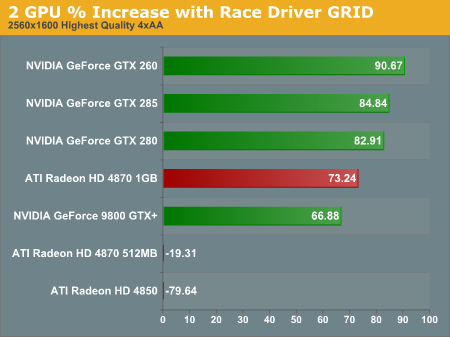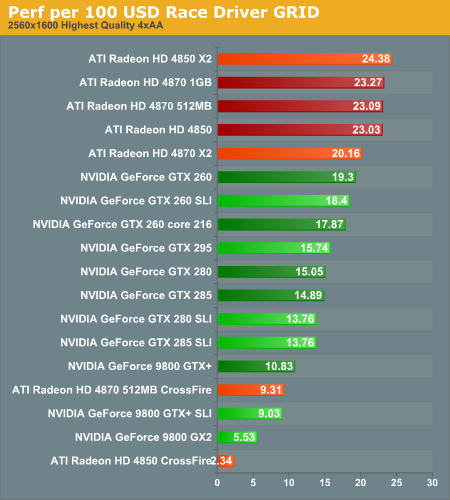MultiGPU Update: Two-GPU Options in Depth
by Derek Wilson on February 23, 2009 7:30 AM EST- Posted in
- GPUs
Race Driver GRID Analysis
This game can really hammer graphics memory at high resolution, but in general performance is very good with GRID across the board. This is a short FRAPS test on a straight section of track at the beginning of a race from the back of the pack.

1680x1050 1920x1200 2560x1600
All cards are playable below 2560x1600 with ultra quality settings in GRID. Moving up in resolution really benefits from more than 512MB of RAM, especially with multiGPU options. 9800 GTX+ SLI, the 9800 GX2, 4870 512MB CrossFire and 4850 CrossFire really tank in performance with the two ATI solutions even providing a negative "improvement." We'd love to see ATI and NVIDIA detect negative performance impact from multiGPU systems and automatically revert to a single GPU, but it's clear from today's tests that neither NVIDIA nor ATI have anything like that going on.
At 2560x1600, any single GPU except for the 9800 GTX+ can handle 2560x1600. We strongly recommend cards with more than 512MB of memory for running at this resolution though, as navigating the menu suffers quite dramatically inspite of playable performance on the track.

1680x1050 1920x1200 2560x1600
We see really good performance scaling in this game, especially from NVIDIA hardware. From 77% to 100% scaling at 1680x1050 and mid to high 80% scaling for 1920x1200 is very imprssive. The best AMD can muster under 2560x1600 is 69% scaling with the 4850. Of course, AMD single GPU options do provide higher performance than their competition from NVIDIA, but the scaling advantage does help the case for SLI here. Looking at 2560x1600, the two 512MB CrossFire options tank completely and 4870 1GB scaling increases to over 73%. SLI still looks better here with 82% to 90% scaling on GT200 based parts. The 9800 GTX+ still scales, but it's low memory and already low single card performance at 2560x1600 make it not a viable solution.

1680x1050 1920x1200 2560x1600
All this translates to our value data as well. Single GPU AMD solutions live up near the top of the chart at all resolutions, while SLI doesn't drop off in value as much as CrossFire (though CrossFire, because of the higher baseline performance and lower cost, tends to accumulate more value than SLI). The 9800 GTX+, because of it's low cost and high scaling, is the exception posting good value numbers for NVIDIA until we hit 2560x1600 (at which point it drops way off).










95 Comments
View All Comments
kmmatney - Monday, February 23, 2009 - link
Especially at the 1920 x 1200 resolution - that resolution is becoming a sweetspot nowadays.just4U - Monday, February 23, 2009 - link
I disagree. I see people finally moving away from their older 17-19" flat panels directly into 22" wide screens. 24" and 1920/1200 resolutions are no where near the norm.SiliconDoc - Wednesday, March 18, 2009 - link
Correct, but he said sweet spot because his/her wallet is just getting bulgy enough to comtenplate a movement in that direction... so - even he/she is sadly stuck at "the end user resolution"...lol
Yes, oh well. I'm sure everyone is driving a Mazerati until you open their garage door....or golly that "EVO" just disappeared... must have been stolen.
DerekWilson - Monday, February 23, 2009 - link
The 1GB version should perform very similarly to the two 4850 cards in CrossFire.The short answer is that the 1GB version won't have what it takes for 2560x1600 but it might work out well for lower resolutions.
We don't have a 1GB version, so we can't get more specific than that, though this is enough data to make a purchasing decision -- just look at the 4850 CrossFire option and take into consideration the cheaper price on the 1GB X2.
politbureau - Tuesday, June 1, 2010 - link
I realize this is an older article, however I always find it interesting to read when upgrading cards.While I find it admirable that Derek has compared the 'older' GTX 280 SLI scaling, it is unfortunate that he hasn't pointed out that it should perform identically to the GTX 285s if the clocks were the same.
This was also passed over in the "worthy successor" article, where it does not compare clock for clock numbers - an obvious test, if we want to discover the full value of the die shrink.
I recently 'upgraded' to 3 GTX 285s from 3 GTX 280s through warranty program with the mfg, and there is little to no difference in performance between the 2 setups. While cabling is more convenient (no 6 to 8 pin adapters), the 285s won't clock any better than my 280s would, Vantage scores are within a couple hundred points of each other at the same clocks (the 280s actually leading), and the temperature and fan speed of the new cards hasn't improved.
I think this is a valuable point in an article that compares performance per dollar, and while slightly outside the scope of the article, I think it's a probabtive observation to make.